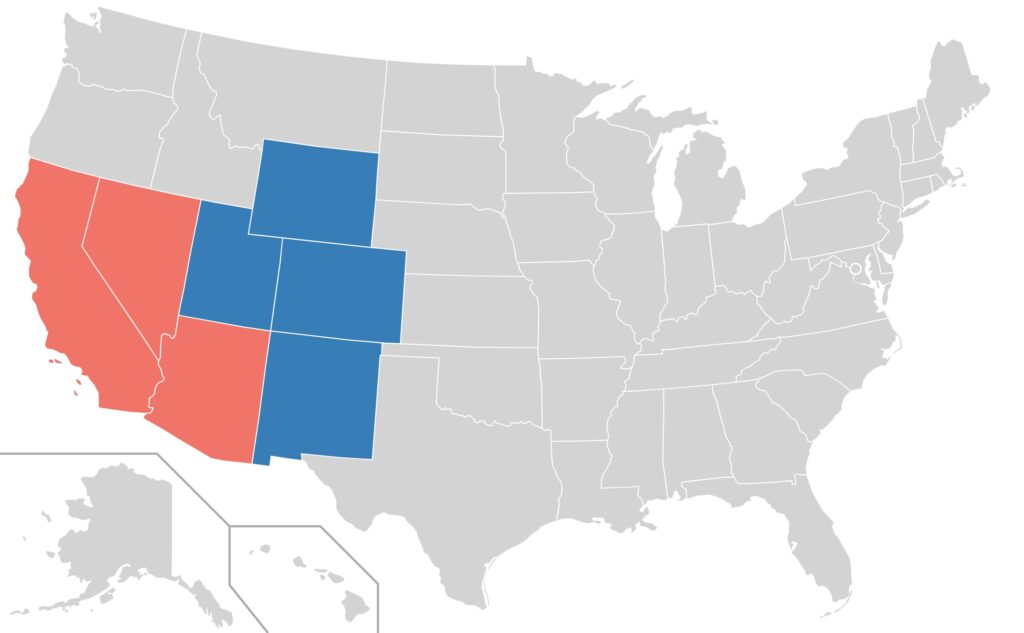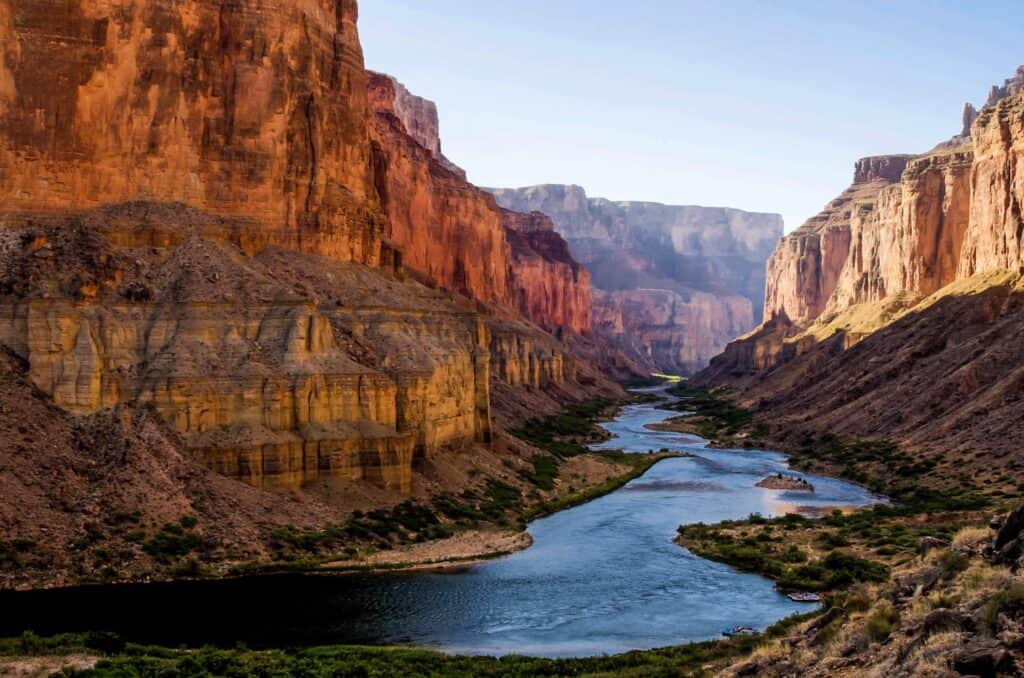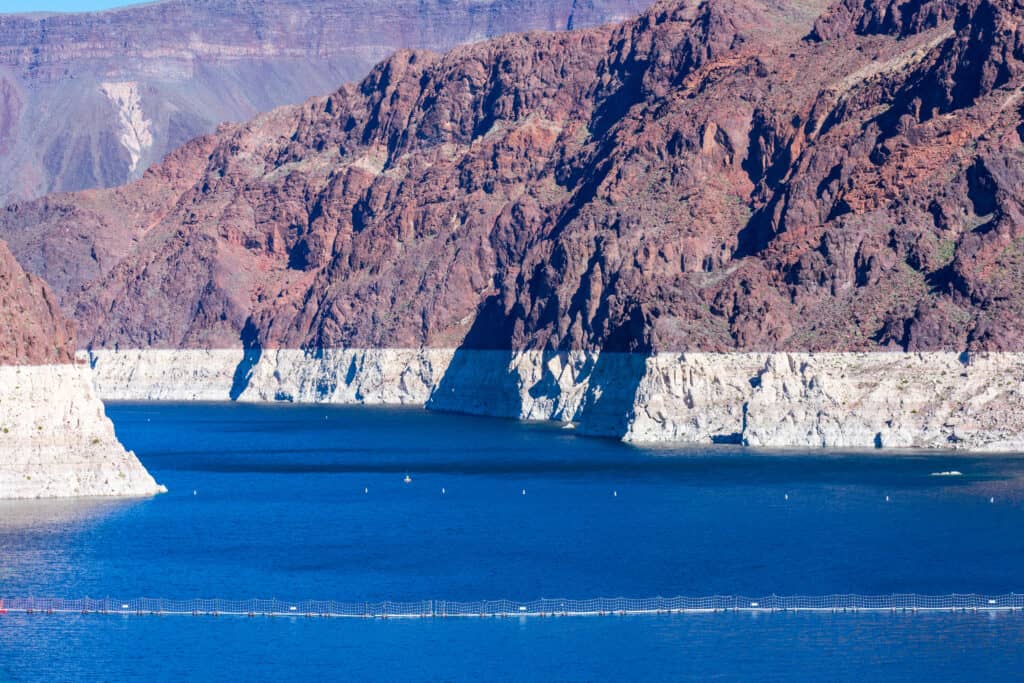Hoover Dam is one of the engineering marvels of the world. Although it is now nearly 100 years old, it continues year after year to supply the Southwestern United States with clean hydroelectric power and water through the reservoir it impounds – Lake Mead. Building it came at a steep cost, though. The construction cost of the project eventually paid for itself, but the loss of human life can never be recovered. This article will explain how and why the dam was built, its importance to the economy of the Southwest, and how many Hoover Dam fatalities there were during its construction.

This map shows the 7 Colorado River Compact states. These states are all part of the river’s watershed. They have agreed that half the water will be used by the upper basin states (in blue) and half by the lower basin states (in red).
©MarginalCost, CC BY-SA 4.0 <https://creativecommons.org/licenses/by-sa/4.0>, via Wikimedia Commons
Why Was Hoover Dam Built?
During the 1920s, until the stock market crash of 1929, the U.S. economy was roaring ahead and people were making money hand over fist. Industrialists were busily constructing infrastructure: railroads, ports, and energy facilities to make money developing the country’s resources. Some of them turned their attention to the possibilities of the Colorado River, which was a major source of water for Colorado, Utah, Nevada, Arizona, California, and Mexico. It could be unpredictable, though, going through seasons of drought followed by violent flash floods. Building a dam with a large reservoir would enable engineers to store up water during heavy rains to be released in a regular, measured way during dry seasons. Moreover, a dam could use the power of rapidly falling water to power electric generators to power the industries and homes of growing cities like Las Vegas. It was decided that locating the dam at a spot where the river forms the border between Arizona and Nevada would be the most advantageous location geologically and in terms of getting the benefits of the project where they could benefit the most people, including those in populous Southern California.

One reason for the Hoover Dam’s construction was to prevent flooding from the Colorado River from affecting Arizona, Nevada, and California.
©Beth Ruggiero-York/Shutterstock.com
When Was Hoover Dam Built?
Although the federal government announced plans to construct the dam in 1922, it wasn’t until 1928 that the project finally completed the approval process, and actual construction didn’t commence until 1931. This meant the project kicked off during some of the darkest days of the Great Depression, a time when enormous numbers of people were unemployed and looking for work, any work, no matter how dirty or dangerous it might be. Public works projects like this were one way to keep people working, and they were eager to do so no matter what rumors might circulate about Hoover Dam fatalities among construction workers.
Herbert Hoover, the namesake of the dam, was President from 1929-1933. His successor, Franklin D. Roosevelt, dedicated the Dam in 1935 although construction wasn’t fully complete until the following year. In all, the project cost $49 million to build, which is the equivalent of $760 million in today’s dollars. The generators and power plant jacked the price up another $71 million. it was a lot of money, but a half-century later, in 1987, Hoover Dam had generated enough profits from electric generation to pay for its own construction costs. In a sense, the dam was, in the end, free. At least financially.

One of the greatest benefits of Hoover Dam is the steady supply of fresh water it provides for agriculture in several dry southwestern states.
©iStock.com/Chris Szwedo
Hoover Dam Fatalities
The human toll of the construction of Hoover Dam can’t be measured in dollars and cents or adequately conveyed in numbers. The project employed about 21,000 people who had to be housed, fed, and entertained. Essentially, it required constructing an entirely new town, still around today, named Boulder, Nevada. The town included a hospital to treat illnesses and injuries among workers. Project managers employed safety precautions, including “high scalers” who scoured the cliffs to either side of the work site to identify and remove any loose rock that might fall on workers. Despite all precautions, 96 people died in construction-related accidents while working on the project. It is a popular myth that some of these fatalities were people who fell into the pouring cement of the dam – this was not the case. Was their sacrifice worth it? In addition to providing for the needs of their families to survive one of the bleakest periods of our country’s history, these workers left behind a monument that has positively impacted the lives of millions of people in the generations since. Let’s see how.

These are high scalers working on the canyon wall of the Hoover Dam construction site in 1934. One of their jobs was to identify and remove unstable rocks that might fall on workers below.
©Everett Collection/Shutterstock.com
How Big is Hoover Dam?
First of all, those workers left behind an absolutely enormous monument of human ingenuity that researchers say could last 10,000 years into the future. Sort of like our civilization’s version of a “great pyramid.” It stands 726 feet tall, about twice as tall as the Statue of Liberty and its pedestal. The dam is 45 feet wide at the top, its thinnest part. This is as wide as a four-lane highway. At its base, though, it’s a whopping 660 feet thick, which is about the length of two football fields! Building it took 3.3. million cubic yards of concrete. That’s enough to pave the driveways of about 200,000 suburban homes!
To strengthen the dam, engineers designed it to be curved, like an arch laid on its side. Romans used arches in their aqueducts and public buildings, and medieval cathedral builders used them in flying buttresses to help support the weight of thin walls with big windows. The genius of an arch is that it transfers the weight above it to its supports below and down to the ground. So then, Hoover Dam’s curved shape channels the huge pressure of the dam itself and the millions of gallons of water behind it into the solid canyon walls on either side, making it a supremely stable structure. It was designed to last for 2,000 years, but with continuous maintenance and upgrading, it could easily last many thousands of years longer, if future generations still have need of it.

The curved shape of the Hoover Dam operates on the same principle as Roman arches or Gothic flying buttresses.
©Michal Plachy/Shutterstock.com
What is the Electric Output of Hoover Dam?
The Dam releases about 20,000 gallons of water per second, channeling it in such a way that it spins generator blades at 180 rpm, driving seventeen 700-ton turbines. The resulting magnetic field generates 4 billion kilowatt-hours of electricity every year. This is enough to serve the needs of 1.3 million people. Nearly 60% of those served live in California and about 20% apiece in Nevada and Arizona. That electricity keeps the lights on in homes and businesses, air conditioning in the sweltering heat of summer, refrigerators and freezers keeping food fresh in grocery stores, and lifesaving equipment running in hospitals. And these days, it also helps keep an increasing number of electric vehicles zipping down the road. Those who were Hoover Dam fatalities helped make modern life itself possible in the whole region.

Clean, renewable Hoover Dam electricity helps keep the lights on all night, every night in Las Vegas and other cities and towns of Nevada, Arizona, and California.
©iStock.com/RandyAndy101
How Much Water Does Hoover Dam Provide?
Hoover Dam took several years after its construction to completely fill Lake Meade, the new reservoir behind it. At full capacity, the Lake should be 112 miles in length, 532 feet at its deepest point, and cover an area of 247.1 square miles. It holds 9.3 trillion gallons of water, the amount that normally flows down the Colorado River in two years’ time. About 70% of this water is used for agriculture. Unfortunately, a long-lasting drought in the region has dropped the lake to just 30% of capacity and there is danger of it drying up completely if more years of drought return. This has led to some proposals for new ambitious projects, like piping water from the Mississippi River to the Colorado River to refill the reservoir – a plan that would be extremely costly and could have a number of negative side effects.

The so-called “bathtub ring” around Lake Mead shows just how far the water level has receded in recent years of drought.
©iStock.com/Michael Vi
Visiting Hoover Dam Today
If you would like to learn more about this national landmark and its construction, including those who were Hoover Dam fatalities, you can take a tour, along with about 1 million other visitors who go there every year. Guides will show you some of the original tunnels used in the construction and finished areas of the control facilities that were decorated in the art-deco style that was popular in the 1930s, and seen in the design details of such buildings as the Empire State Building. The dam has a viewing platform with dizzying views, and you can walk over the highest concrete arch bridge in the world to get a bird’s eye view of the dam. An interesting experiment some visitors enjoy doing is pouring a bottle of water over the side of the dam to see how Hoover Dam “defies gravity” and makes water flow up instead of down. There’s no great mystery; it’s the result of a strong updraft generated by the curvature of the dam in a narrow gorge. But it’s a cool trick to show your kids.
Many visitors also enjoy the Lake Mead National Recreation Area. It encompasses the dam and reservoir and surrounding areas to preserve the area for wildlife and recreation. Camping and hiking are allowed, as well as hunting and fishing with the proper licenses. It’s all just an hour’s drive or so from Las Vegas, so next time you’re out there, consider driving out to see what made it all possible. And remember those who made the ultimate sacrifice in a way that continues to benefit us today.
The photo featured at the top of this post is © iStock.com/Sean Pavone
Thank you for reading! Have some feedback for us? Contact the AZ Animals editorial team.






